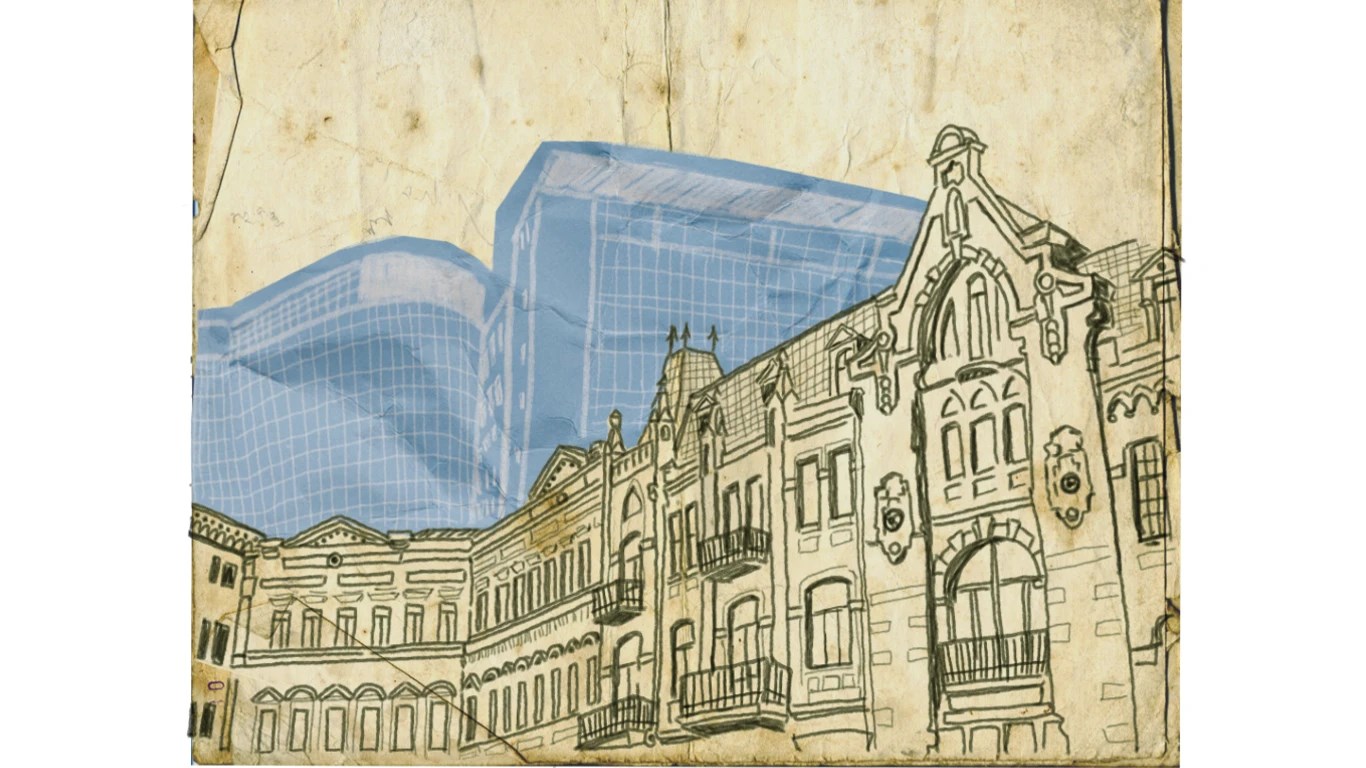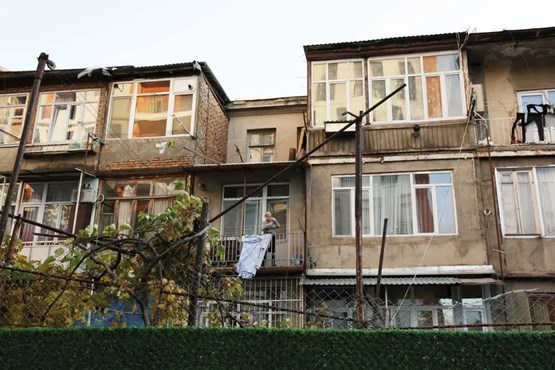
What is happening to Tbilisi?
27.10.2023 | 8 Min to readThe below article was submitted to the National Trust of Georgia by a foreign consultant who’d worked in Georgia. It came anonymously, probably because they want to work here again. Although critical in its comparison with other European cities, we thought the opinion contemporary enough to be aired. Questions of modernity in city design and planning are being asked, not only here. This to the degree it seems worthy to further the discussion by proposing an additional forum to boldly ask the question - what is truly ‘modern’ in architecture and practical urban design, post, post, post-Modern? Tbilisi has to be one of the best venues to ask this – as its face transforms more rapidly than most other capital cities, and its historical zones are swallowed up with such unusual, and many say, alarming speed.
- Peter Nasmyth, Co-Chair, The National Trust of Georgia.
What we’re starting to see is a city slowly fragmenting itself - losing its identity, being swallowed into the grand uniformity of international, mass-design culture. The new, high-rise architecture of Tbilisi is spreading like an eerie fungus across the urban landscape and into the historic zones. It is, like never before, in danger of swallowing up that essence of what is Georgia, or to be Georgian.
This, unfortunately is not an overstatement. And very sad for all those who love the city – Georgians and foreigners alike.
A fact made all the more obvious when looking at other historic Eastern European capitals where this has not been allowed to happen. And Tbilisi has more history than most. Look at the centre of cities like Tallin, Riga, Budapest, Prague - for the large part, elegantly preserved.
Nor is what’s happening to the city’s face ‘modern.’ The new architecture and its philosophy, is in fact, old – 1980s, and way out of date. Current trends in architecture are bringing the curve back into building design; non-symetries, low lying, community friendly structures. Greenery is being incorporated into highrises – as vertical forests. Grass roofs are re-appearing – like they used to have in Tbilisi’s Kala district in the 19th century, when neighbours shared rooves with each other. Natural insulation techniques are back in vogue – also some as previously used. Now the latest fashion is intelligent re-use of materials; restoration instead of demolition; using local, vernacular materials, instead of long-distance imports. Far less use of hardwoods, expensive and rare granites and marbles; more use of naturally found stone – and Georgia has a geology second to none in Europe.
‘All very well for the rich to indulge these fashionable new extravagances,’ the old style planners and architects say. ‘But for the normal, less wealthy Georgians, not an option. We have no choice but follow the cheapest routes.’
But this isn’t accurate either. ‘Cheap’ too often is a concept more to do with profit than the reality of a habitable structure. Low-cost renovation, which preserves the character of a building is very possible – if there is a shift in mentality towards slow reconstruction – just as we are seeing in ‘slow food,’ and ‘slow travel.’
‘Slow construction’ means repair with pride, re-use with intelligence, and if possible, non-demolition. Don’t throw away the old wooden windows and doors, repair them. Keep the existing old wood shutters. They provide far better insulation, look far better than curtains, or plastic-framed double glazing.
It also helps to shift the definition of beauty, both in architecture and life in general. One with a sense of the overall environment; on maximising quality of life over investment return. But also, not taking either to extreme; so there is some give and take on either side.
 All this is slightly ironic in Tbilisi, where the city’s formative presence - its friendly low-lying balconies, carved wood, Art Nouveau frontages, painted entrance-halls - are admired by every Georgian citizen. Images of them adorn TV and street advertising, appear on food products, wine bottles, are copied repeatedly in restaurant design. But still they are being steadily knocked down. The personality of these buildings connects intimately with the personality of the people. Yet this new post-modern Sovietisation is sweeping across the city districts and hillsides – with its message of standardisation; economic and profit logic, limited imagination. Hard straight lines; reflective surfaces - tolerable in small quantities, even interesting as a contrast to highlight the beauty and subtlety of old architecture - is now starting to dominate, take over, giganticise and overshadow, the older, smaller, more community-encouraging buildings. The city’s historic cultural identity is now being destroyed more thoroughly than Ahmed Khan, who tried to erase the old town in 1795.
All this is slightly ironic in Tbilisi, where the city’s formative presence - its friendly low-lying balconies, carved wood, Art Nouveau frontages, painted entrance-halls - are admired by every Georgian citizen. Images of them adorn TV and street advertising, appear on food products, wine bottles, are copied repeatedly in restaurant design. But still they are being steadily knocked down. The personality of these buildings connects intimately with the personality of the people. Yet this new post-modern Sovietisation is sweeping across the city districts and hillsides – with its message of standardisation; economic and profit logic, limited imagination. Hard straight lines; reflective surfaces - tolerable in small quantities, even interesting as a contrast to highlight the beauty and subtlety of old architecture - is now starting to dominate, take over, giganticise and overshadow, the older, smaller, more community-encouraging buildings. The city’s historic cultural identity is now being destroyed more thoroughly than Ahmed Khan, who tried to erase the old town in 1795.
And this is damaging to the psychology of the people – in subtle, hidden ways. The disappearing, friendly low-lying areas of Tbilisi, are being gobbled up by tall, over-shadowing, oppressive apartment blocks. Vake, a relatively new section of the city, already spends most of its day, cowering in the shadows of dominating monsters. Now the march of the concrete giants is focussing its sights on neighbouring Vera, classified as a ‘Historic’ zone. A number of smaller vernacular buildings have already been demolished, replaced by buildings twice, sometimes four times their size. Permissions are either being ignored, or not even sought.
The argument is, because owners have no money to restore the houses themselves, the only solution is to let the developers knock them down and replace. But this is a way too simple solution to a common, all-over-the-world dilemma. It doesn’t have to happen this way, or at least, nearly so frequently. There are plenty of ways to renovate buildings and their districts without destroying them.
 A typical example of what’s happening in Tbilisi, is one formerly, elegant, 19th century house on Vera’s Makashvili street. It needed refurbishment inside – no question. But instead the entire building was flattened, dug down deep, then two story frontage reconstructed with a few historic references to what was before. After that a vast, a bulbous, quadrupling-in-size monster was plonked down on top. The small two story frontage looks completely out of place - like a comic, or rather, humiliating reference to the local character that has just been destroyed. The new structure has the effect of domineering all the other local buildings, changing the tone of the street, making people less inclined to want to live there. This, with the cumulative effect of others like it (there’s a growing number in Vera) – slowly translates into the whole neighbourhood. It lowers the overall value and desirability of what was once a historic area. Soon this Vake-isation will spread across the river, if a proper building code isn’t adopted and more importantly - enforced.
A typical example of what’s happening in Tbilisi, is one formerly, elegant, 19th century house on Vera’s Makashvili street. It needed refurbishment inside – no question. But instead the entire building was flattened, dug down deep, then two story frontage reconstructed with a few historic references to what was before. After that a vast, a bulbous, quadrupling-in-size monster was plonked down on top. The small two story frontage looks completely out of place - like a comic, or rather, humiliating reference to the local character that has just been destroyed. The new structure has the effect of domineering all the other local buildings, changing the tone of the street, making people less inclined to want to live there. This, with the cumulative effect of others like it (there’s a growing number in Vera) – slowly translates into the whole neighbourhood. It lowers the overall value and desirability of what was once a historic area. Soon this Vake-isation will spread across the river, if a proper building code isn’t adopted and more importantly - enforced.
For outsiders it is no surprise to see a large balloon with the word M2 (symbol for 'square metres') hanging over the city's most central park - Rikhe. This popularisation of building size and by inference, prices per square metre, seems not only to dominate Tbilisi’s skyline, but also decision making. For extra square metres means extra profit. And if extra floors are denied planning permission, they are often built anyway and the fine paid – if it is even levied.
What is being forgotten is that this increased-size value is short term. Especially as the old, historic buildings, are in ever shorter supply. If properly maintained, their value will increase far quicker than their larger, characterless new neighbours. This is one of the factors that saved Budapest after the collapse of the Soviet Union. The same also applies to the simulation-old, rebuilds, with their extra floors stuck on top – like in Tbilisi’s once charming Puri Square, or Kala district – where buildings were erased and replaced as giant, pastiches of themselves. Where tourists walk around scratching their heads wondering if this Disney rendition of the past, reflects anything that ever existed before. And if so, what kind of sociable, child and family friendly community had once thrived there – as the local population moves out and ‘For Sale’ in English signs proliferate in the windows
 While planners, city leaders and building-code enforcers must receive some blame, almost as guilty is the general lack of information. People are not being told of the alternatives. Home owners for the most part see the solution to their old, sagging floorboards, kitchens and bathrooms, as demolition and new build. They are being told that 1980s ‘modern’ is 2023 modern. They remain ignorant of the fact that renovation is not only simpler, easier, more sympathetic to the neighbourhood, but also cheaper. However it is slower – and this is the rub. Which of course suits the developers, keen to capitalise on owner impatience and frustration; simply knock down, reconstruct and watch the square metres and laris roll in.
While planners, city leaders and building-code enforcers must receive some blame, almost as guilty is the general lack of information. People are not being told of the alternatives. Home owners for the most part see the solution to their old, sagging floorboards, kitchens and bathrooms, as demolition and new build. They are being told that 1980s ‘modern’ is 2023 modern. They remain ignorant of the fact that renovation is not only simpler, easier, more sympathetic to the neighbourhood, but also cheaper. However it is slower – and this is the rub. Which of course suits the developers, keen to capitalise on owner impatience and frustration; simply knock down, reconstruct and watch the square metres and laris roll in.
Tbilisi is certainly not unique in this phenomenon. But it is increasingly unique in the way that historic, carbon-containing buildings are being demolished wholesale – carbon released – and then replaced by monsters. How the character of whole districts – like Vera - is being killed off slowly and insidiously. The personality of the people with it – as they are priced out of their own homes.
Budapest and Prague managed to save their historic districts by creating careful planning codes and enforcing them. Tbilisi could easily do the same – by perhaps remembering that Joni Mitchell hit from the 1970s whose refrain quoted the old saying,
‘you don’t know what you’ve got until it’s gone’
We Recommend





